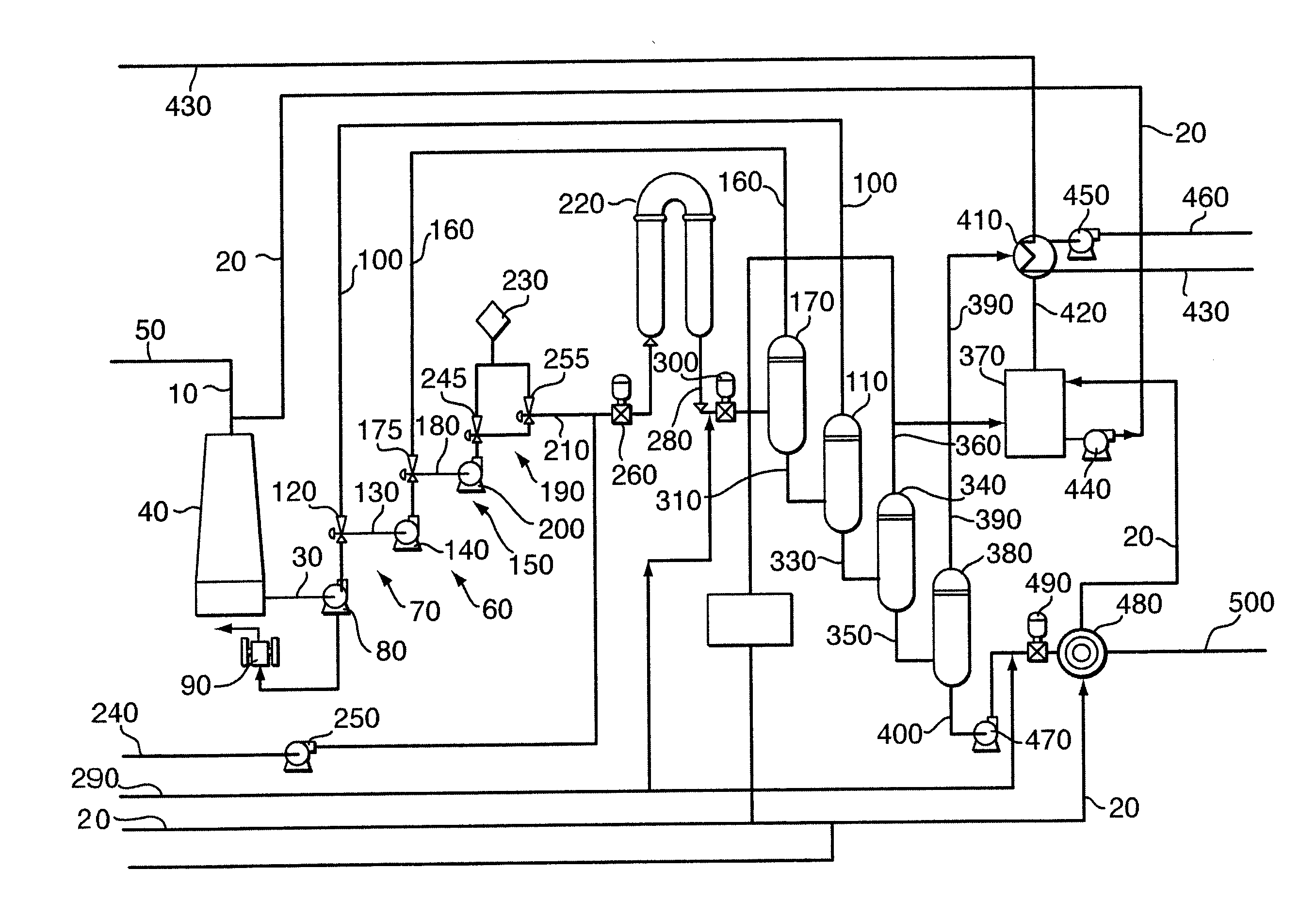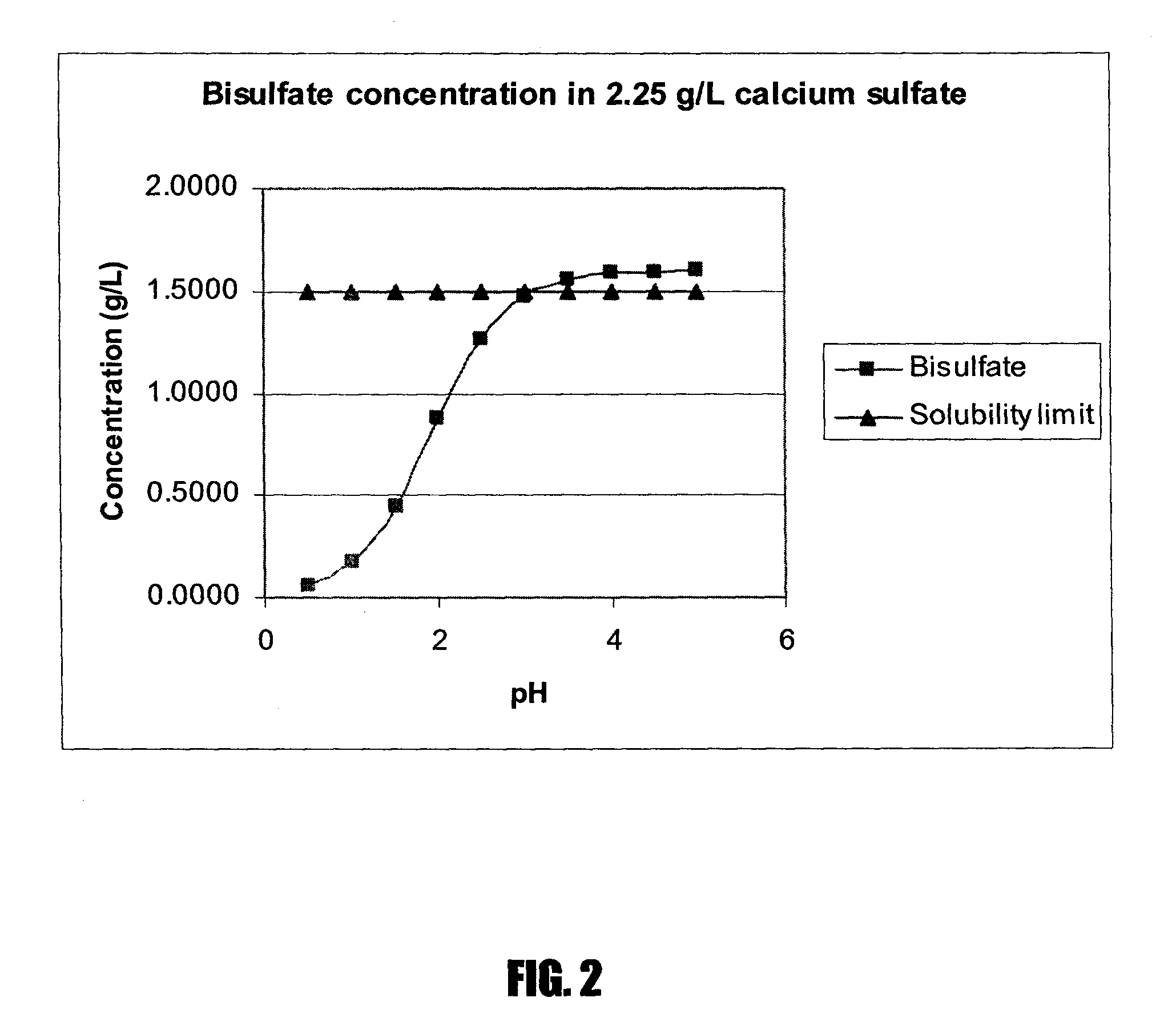Method of Continuous Processing of Lignocellulosic Feedstock
a technology of lignocellulosic feedstock and continuous processing, which is applied in the preparation of sugar derivatives, saccharides, sugar derivatives, etc., can solve the problems of poor environmental protection, high cost of feedstocks, and high use costs of feedstocks, so as to reduce the amount of downstream equipment exposed to harshly acidic feedstocks, avoid sugar degradation, and facilitate uniform distribution
- Summary
- Abstract
- Description
- Claims
- Application Information
AI Technical Summary
Benefits of technology
Problems solved by technology
Method used
Image
Examples
example 1
The Pretreatment of Lignocellulosic Feedstock
[0134]In this non-limiting example, wheat straw is used as the feedstock (e.g. 10, FIG. 1). The feedstock may be prepared by a shearing or crushing operation, such as hammer-milling, to produce small particles, preferably 40, with a process water stream 20. The process water stream 20 is at a temperature of about 93° C. and is flowing at 370,000 kg / hr. The resulting feedstock slurry 30 has a solids content of 14.4% by weight. Prior to preparing the slurry 30, the feedstock 10 may be leached 50 to remove inorganic salts.
[0135]The feedstock slurry 30 is conveyed by a first transfer pump 80 to a first stage 70 of a heating train 60. First transfer pump 80 is preferably a MC® (medium consistency) pump to handle the thick slurry. The first transfer pump 80 may be connected to a first vacuum pump 90 that de-aerates the slurry 30. The heat to the first stage 70 may be provided by direct injection of second steam and volatiles stream 100 provided...
example 2
Adjustment of pH of Sulfuric Acid to Decrease Corrosion of Stainless Steel
[0145]The effect of pH on the rate of corrosion of stainless steel was measured by incubating solutions of 1% sulfuric acid at various pH values in small bombs. The bombs were made of 304 stainless steel and 316 stainless steel, with compositions listed in Table 1.
TABLE 1Composition of stainless steelMetal (element)304 stainless steel (%)316 stainless steel (%)Iron68-7263-70Manganese22Chromium18-2016-18Nickel 8-1010-14Molybdenum02-3
[0146]The incubations were carried out for 7.5 hr at 200° C. at a mass of 250 grams. After the incubations, the degree of corrosion was measured, and the results are shown in Table 2. Increasing the pH from 1.05 to 2.06 decreased the rate of corrosion by over 98% for both 316 and 304 stainless steel. Increasing the pH to 3.24 further decreased the rate of corrosion to a level that was reduced by more than 99.7% relative to the natural 1% sulfuric acid solution.
TABLE 2Rate of corrosi...
example 3
Pretreatment of Wheat Straw with Interim pH Adjustment Using Sodium Hydroxide
[0148]Wheat straw was received in bales measuring 3 feet by 3 feet by 4 feet. The wheat straw consisted of 60.3% carbohydrates, 18.7% lignin, 3.6% protein, 3.1% silica, and 4.9% non-silica salts. The salts included 1.2% potassium, 0.57% calcium, 0.04% sodium, 0.15% magnesium and 0.04% phosphate. A batch of 30 tonnes of the straw was hammer-milled to ⅛ inch length and slurried in water (20; FIG. 1) at a ratio of 8 parts water to 1 part solids. The slurry was pumped through piping heated by direct injection with 350 psig steam to reach a temperature of 185° C. Once at this temperature, dilute sulfuric acid (240) was added to achieve a concentration of 0.9% acid (w / w). The heated, acidified stock was maintained at this condition for 2 minutes as it passed through a pretreatment reactor (220) having an 8 inch diameter.
[0149]At the exit of the pretreatment reactor (220), and before the slurry entered a section o...
PUM
| Property | Measurement | Unit |
|---|---|---|
| pH | aaaaa | aaaaa |
| pH | aaaaa | aaaaa |
| pressure | aaaaa | aaaaa |
Abstract
Description
Claims
Application Information
 Login to View More
Login to View More - R&D
- Intellectual Property
- Life Sciences
- Materials
- Tech Scout
- Unparalleled Data Quality
- Higher Quality Content
- 60% Fewer Hallucinations
Browse by: Latest US Patents, China's latest patents, Technical Efficacy Thesaurus, Application Domain, Technology Topic, Popular Technical Reports.
© 2025 PatSnap. All rights reserved.Legal|Privacy policy|Modern Slavery Act Transparency Statement|Sitemap|About US| Contact US: help@patsnap.com



